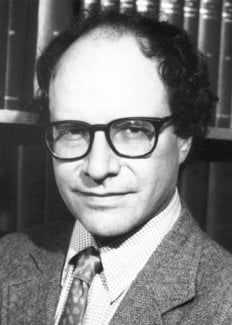Walter Gilbert
Biographical

I was born on March 21, 1932 in Boston, Massachusetts. My father, Richard V. Gilbert, an economist, was at that time at Harvard University. He worked for the Office of Price Administration during the second World War and later headed up a planning group advising the Pakistani government. My mother, Emma Cohen, was a child psychologist, who practiced giving intelligence tests to me and my younger sister. She educated us at home for the first few years, to keep my sister and me amused. We loved reading and raided the adult section of the public library. In 1939 my family moved to Washington D.C.; I was educated there in public schools, later at the Sidwell Friends high school.
I always had an interest in science, in those years minerology and astronomy (I was a member of a minerological society and an astronomical society as a child). I became interested in inorganic chemistry at high school. In my last year in high school, 1949, I was fascinated by nuclear physics and would skip school for long periods to go down to the Library of Congress to read about Van de Graaf generators and simple atom smashers. I went to Harvard and majored in chemistry and physics. I became interested in theoretical physics and, as a graduate student, worked in the theory of elementary particles, the quantum theory of fields. I spent my first graduate year at Harvard, then went to the University of Cambridge for two years, where I received my doctorate degree in 1957. My thesis supervisor was Abdus Salam; I worked on dispersion relations for elementary particle scattering: an effort to use a notion of causality, formulated as a mathematical property of analyticity of the scattering amplitude, to predict some aspects of the interaction of elementary particles. I met Jim Watson during this period. I returned to Harvard and, after a postdoctoral year and a year as Julian Schwinger’s assistant, became an assistant professor of Physics. During the late fifties and early sixties, I taught a wide range of courses in theoretical physics and worked with graduate students on problems in theory. However, after a few years my interests shifted from the mathematical formulations of theoretical physics to an experimental field.
In the summer of 1960, Jim Watson told me about an experiment that he and Francois Gros and his students were working on. I found the ideas exciting and joined in for the summer. We were trying to identify messenger RNA, a short-lived RNA copy of a DNA gene, which serves as a carrier of information from the genome to the ribosomes, the factories that make proteins. After each messenger is used a few times to dictate the structure of a protein, it is broken down and recycled to make other messenger RNA molecules. The experiments sought a fleeting new component that we finally managed to pin down. I found the experimental work exciting and have continued research in molecular biology ever since.
After a year of work on messenger RNA, I returned briefly to physics then came back to biology to study how proteins are synthesized. I showed that a single messenger molecule can service many ribosomes at once and that the growing polypeptide chain always remains attached to a transfer RNA molecule. This last discovery illuminated the mechanism of protein synthesis: the protein chain is transferred in turn from one amino-acid-bearing transfer RNA to another as it grows, their order dictated by messenger RNA and ultimately by the genetic code on the DNA. In the middle sixties, Benno Müller-Hill and I isolated the lactose repressor: the first example of a genetic control element. A repressor is a protein product made by one gene in the bacterium in order to control a second gene by turning it off when its product is not wanted. This control function had been defined genetically by the work of Jacob and Monod, but a repressor is made in such small amounts that it was an extraordinarily elusive biochemical entity. We identified, characterized, and purified one. We developed bacterial strains which made several thousand fold more protein, and showed how that repressor functioned. In the late sixties, David Dressler and I invented the rolling circle model, which describes one of the two ways DNA molecules duplicate themselves. In the early seventies I isolated the DNA fragment to which the lac repressor bound and studied the interaction of the bacterial RNA polymerase and the lac repressor with DNA. In the middle seventies, Allan Maxam and I developed the rapid chemical DNA sequencing. At this time, I also became interested in and developed some of the recombinant DNA techniques, specifically showing that blunt end ligation was efficient in putting DNA fragments together. In the late seventies with Lydia Villa Komaroff and Argiris Efstratiadis I worked on bacterial strains that expressed a mammalian gene product, insulin. Currently I am interested in, on one hand, the making of useful proteins in bacteria and, on the other hand, the structure of genes and the evolution of DNA sequences.
After my change from physics to molecular biology, I was promoted at Harvard in Biophysics and later in Biochemistry and Molecular Biology. Since 1974 I have been an American Cancer Society Professor of Molecular Biology.
I am married to Celia Gilbert, a poet, and have two children, John Richard and Kate.
This autobiography/biography was written at the time of the award and later published in the book series Les Prix Nobel/ Nobel Lectures/The Nobel Prizes. The information is sometimes updated with an addendum submitted by the Laureate.
Nobel Prizes and laureates
Six prizes were awarded for achievements that have conferred the greatest benefit to humankind. The 12 laureates' work and discoveries range from proteins' structures and machine learning to fighting for a world free of nuclear weapons.
See them all presented here.
